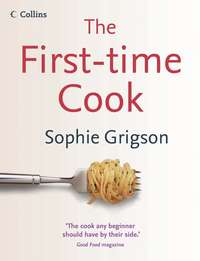
Полная версия
Vegetables
1.5 litres (23/4 pints) water or vegetable stock
juice of 1–2 limes
150ml (5 floz) soured cream
leaves from a small bunch of mint
salt and pepper
Put the onion, sweet potato, ginger, garlic, star anise and sunflower oil into a roomy pan and stir around. Place over a low heat, cover tightly and leave to sweat for 10 minutes, then add the tomato purée, cinnamon, lentils and water. Bring up to the boil, then reduce the heat and leave to simmer until the lentils and sweet potato are very tender. Season with salt and pepper.
Remove the star anise, then liquidise the soup or pass through a mouli-légumes. Stir in as much lime juice as you like. Taste and adjust seasoning.
Reheat when needed, and spoon into bowls. Finish each one with a little soured cream and a small handful of mint leaves on top.
Southern sweet potato pie
This is far better than pumpkin pie. Don’t be scared to line the pastry case with clingfilm – it’s a pastry chef’s trick and it works brilliantly, lifting out perfectly every time. And no, it won’t melt either.
Serves 8
3 large sweet potatoes, about 1.5 kg (31/4lb) in total
300 g (11 oz) sweet shortcrust pastry
30g (1 oz) softened butter
100 g (31/2 oz) caster sugar
1 teaspoon vanilla extract
1/2 teaspoon ground cinnamon
a generous grating of nutmeg
4 tablespoons double cream
1 egg
3 egg yolks
Meringue topping
3 egg whites
150g (5oz) caster sugar
Preheat the oven to 190°C/375°F/Gas 5. Put the sweet potatoes in to bake.
Meanwhile, line a 23–25 cm (9–10in) tart tin with the pastry, prick the base with a fork, and chill in the fridge for half an hour. Line the pastry case with clingfilm and fill with baking beans. Bake blind for 10 minutes, then take out of the oven and remove the beans and clingfilm. Return the pastry case to the oven and bake for a final 5 minutes. Leave to cool.
Once the potatoes are done, scoop out the flesh and weigh out 950g (2lb 2 oz). Beat in the butter, sugar, vanilla extract and spices while still hot. Next beat in the cream, then the egg and yolks. Scrape the mixture into the awaiting pastry case, smooth down and return it to the oven. Once the door is closed, turn the heat down to 180°C/350°F/Gas 4 and leave to bake for around 20 minutes, until almost set.
As it cooks, whisk up the egg whites for the meringue topping until they stand in firm peaks. Sprinkle over half the sugar and whisk again until the meringue is light and glossy and billowing, then fold in the remaining sugar. Spoon the meringue on to the hot baked pie, spreading out right to the edge and completely covering the filling. Make swirls and peaks in the meringue, then return the pie to the oven (last time) and bake for 15 minutes, until the meringue is browned nicely. Serve warm or cold, with plenty of cream.
Turnips
I got off to a good start with turnips, thanks to an alcoholic chef called Monsieur Bastard. He owned the restaurant at the end of the French village my family decamped to every spring and autumn. The evening we arrived we invariably ate at The Ariana. The first spoonful of M. Bastard’s vegetable soup signalled the proper start of the holiday, and we cheered whenever jambon aux navets appeared on the menu. I still salivate at the thought of that thick slice of fine French ham and tender, glazed turnips that surrounded it.
Not everyone is so lucky. Bad turnips are enough to dismay the most ardent of vegetable eaters, let alone youngsters who are just embarking, often against their will, on the road to vegetable-appreciation. Or not. Which is a shame, because at their best turnips are downright sexy. Not the hefty, awkward lumps shrouded in tough green and grey skin fit only to be fed to cattle, not humans. No, I’m talking about the cute sorts of turnip: smaller than a tennis ball, with a handsome flush of pink or purple, waxy, tender skin and crisp white flesh.
The trouble is that the ideal turnip, sold marble-sized in fetching bunches, is horribly expensive and far too rare – good arguments for growing your own, so that you can enjoy them as fresh as can be. Failing that, you must regard turnips as a rare indulgence, especially if you have children. Never force-feed them rank monster turnip in the hopes that they will eventually grow to enjoy it. They won’t. They’ll probably never eat turnip again. Instead, restrain your turnip intake to once or twice a year, only when you can buy and cook small, sexy turnips that will tempt one and all.
Practicalities
BUYING
Turnips must, must, must be eaten young and impeccably fresh. Over-large or stale turnips are a penance we could all do without. Beauty is for once a reliable guide. Look for pert small turnips, prettily blushed with pale purple or pink, over pearly white skin. Medium-sized green and white turnips are just about acceptable, but big bruisers are to be avoided unless you are a masochist. Only buy turnips, even the most perfect little darlings, when you are sure that you will be eating them within the next 48 hours.
COOKING
Extra small turnips (think quail’s egg or walnut-sized), bunched together fetchingly, are the ne plus ultra, the apex of deliciousness. Don’t muck around with them – just trim the stems off a centimetre from the base, rinse well, nip off thready rootlets, then steam or blanch whole in lightly salted water for a few minutes until tender-crisp. Well drained and served immediately, they need no embellishment at all. If you want a dab of butter, fine, but it really isn’t necessary. There’s only one more complex dish that I’d recommend using them for, and that’s a navarin printanier, the remarkable French stew of spring lamb and baby vegetables in a creamy sauce. Otherwise, leave them alone.
As they mature, the turnip flavour matures too and the outer skin toughens. As they approach tennis-ball size, they will probably need to be peeled. Before that it isn’t necessary unless the skin is discoloured. Raw turnip is rarely used in salads, which is a shame, as it has a pleasing crisp juiciness – try it thinly sliced in the Malaysian rujak on page 121, for instance, or tossed with crisp sweet lettuce leaves, thinly sliced eating apple and walnuts in a lemony dressing.
Medium turnips are open to more adventurous approaches, as long as they do not include a crude white sauce, which does nothing for them. I often roast them with a little olive oil, or serve steamed or boiled turnip quarters sprinkled with a gremolata (a very finely chopped blend of lemon zest, parsley and garlic), or drizzled with bright green parsley and basil oil (literally a little olive, sunflower or avocado oil liquidised with a handful of tender herb leaves).
As they swell up, you: a) will have to peel off the tough skin, and b) would be well advised to blanch the turnips before finishing the cooking. In other words, cut the turnip into cubes or slices and drop into boiling water for 3 minutes or so, before draining thoroughly. This softens the less appealing aromas, without destroying the flavour or texture completely. Finish off the cooking when needed by sautéing them in butter or, better still, glazing them, for which I give a recipe overleaf.
Glazed turnips with orange and honey
There are many ways to glaze a turnip. The simplest is to finish the cooked turnips in butter and sugar, stirring them over a moderate heat until the sugar dissolves, and the turnips begin to colour. This recipe brings orange juice and honey into play as well.
Serves 4
500g (1 lb 2oz) medium turnips
finely grated zest of 1/2 orange
juice of 1 large orange
30g (1oz) butter
1 tablespoon light runny honey
salt and pepper
Peel the turnips and cut into 2cm (3/4 in) cubes. Blanch in boiling water for 3 minutes, then drain thoroughly. Wipe out the saucepan and return the turnips to it, adding all the remaining ingredients together with a splash of water. Return to a moderate heat and stir until the butter has melted. Simmer, stirring frequently, until the liquid has all evaporated, leaving the turnips glossy with their buttery, orange glaze. Serve swiftly.
Torshi lift Turnip and beetroot pickles
I love the habit, at some North African restaurants, of bringing a plate of raw vegetables, olives and pickles to nibble on while you wait for the food. Very civilised, and naturally far better for you than stuffing in slices of bread and butter. I grab the startlingly pink crescents of pickled turnip – torshi lift – first. This pickle is crisp and juicy and very more-ish (as well as being Moorish). The colour comes from the inclusion of a few slices of beetroot, but the base flavour is the sweet, juicy, raw turnip. It doesn’t take long to make, and is a good addition to a plate of charcuterie, or served with cheese at the end of a meal.
Fills a 1 litre (13/4 pint) jar
1kg (21/4 lb) small/medium turnips
1 large raw beetroot
4 cloves garlic, thinly sliced
a small bunch of celery leaves
4 tablespoons sea salt
350ml (12floz) white wine vinegar
Peel the turnips and cut them in halves or quarters, depending on their size. Peel the beetroot, cut it in half and slice. Pack into sterilised preserving jars (see page 215), alternating layers of turnip and beetroot and interspersing with garlic slices and celery leaves.
Mix the salt with 1 litre (13/4 pints) water in a saucepan and bring up to the boil, stirring until the salt has dissolved. Add the vinegar, stir and then pour over the vegetables, making sure that they are completely submerged. Seal with non-corrosive lids.
Store in a warm (not hot) place – say a shelf in the kitchen. Leave them alone for 10–12 days. Once they are slightly softened and suffused with pink, move the jars to a cool place, where they will keep happily for a month or so.
Конец ознакомительного фрагмента.
Текст предоставлен ООО «ЛитРес».
Прочитайте эту книгу целиком, купив полную легальную версию на ЛитРес.
Безопасно оплатить книгу можно банковской картой Visa, MasterCard, Maestro, со счета мобильного телефона, с платежного терминала, в салоне МТС или Связной, через PayPal, WebMoney, Яндекс.Деньги, QIWI Кошелек, бонусными картами или другим удобным Вам способом.




